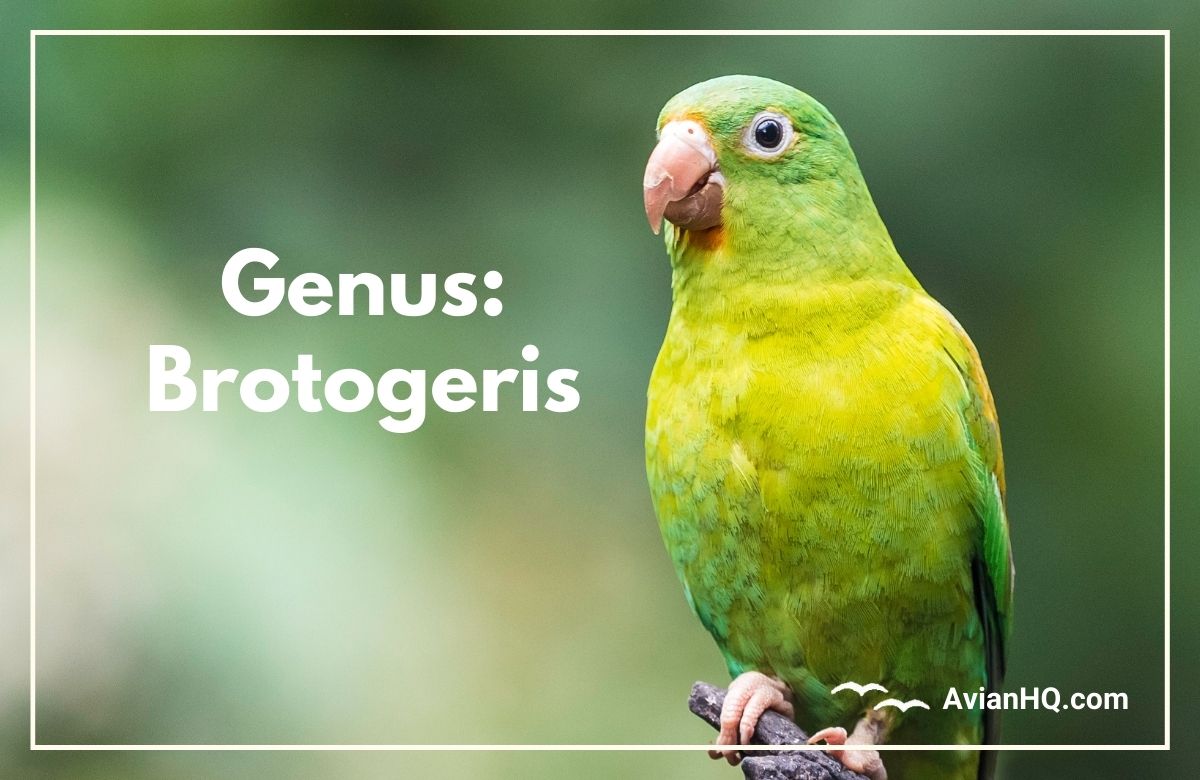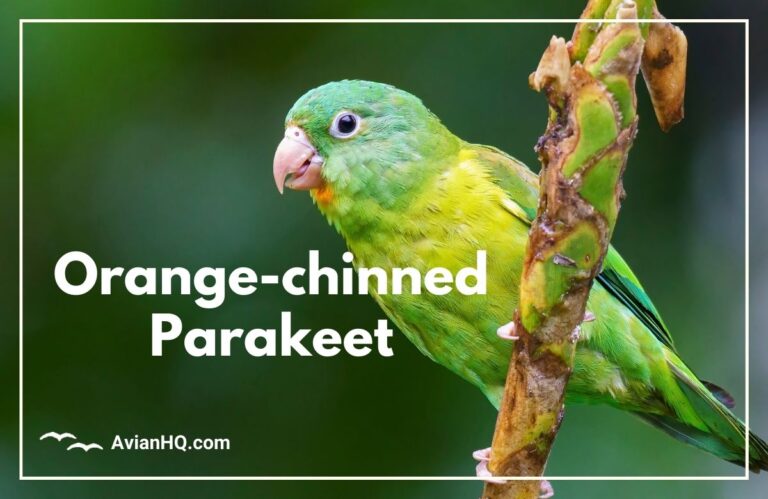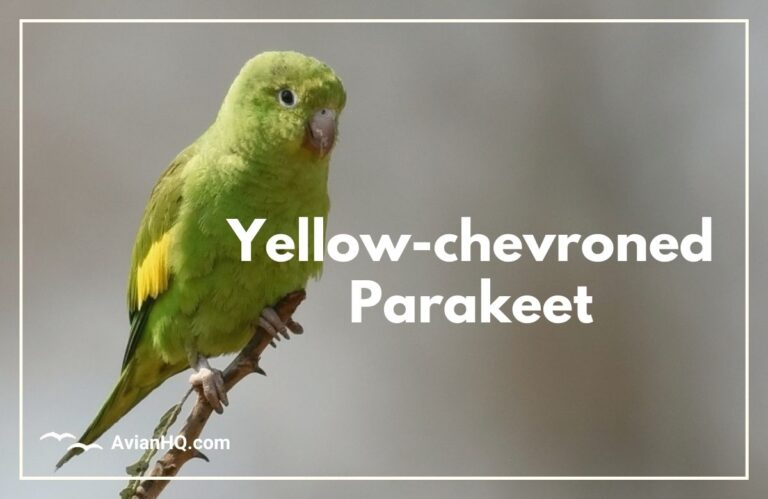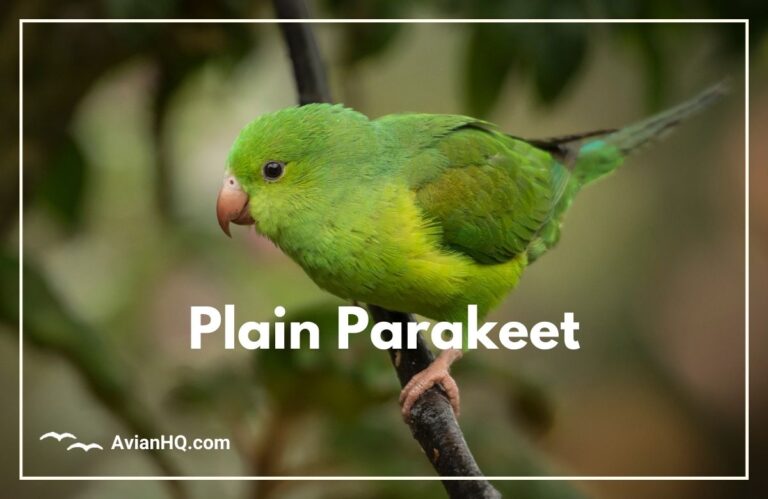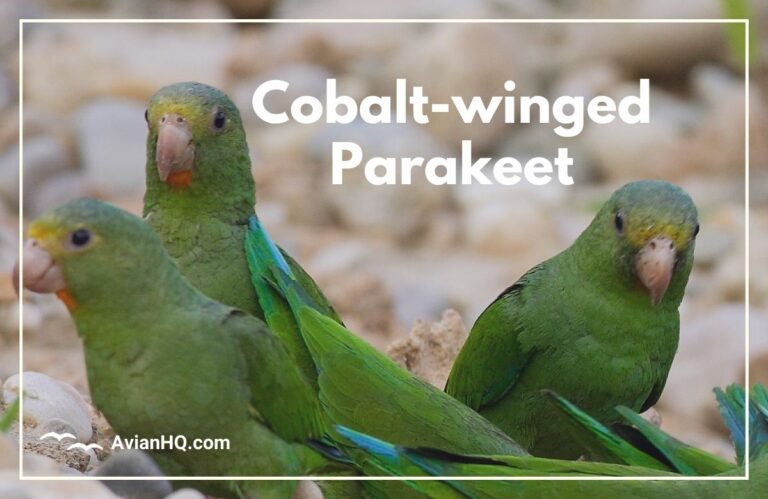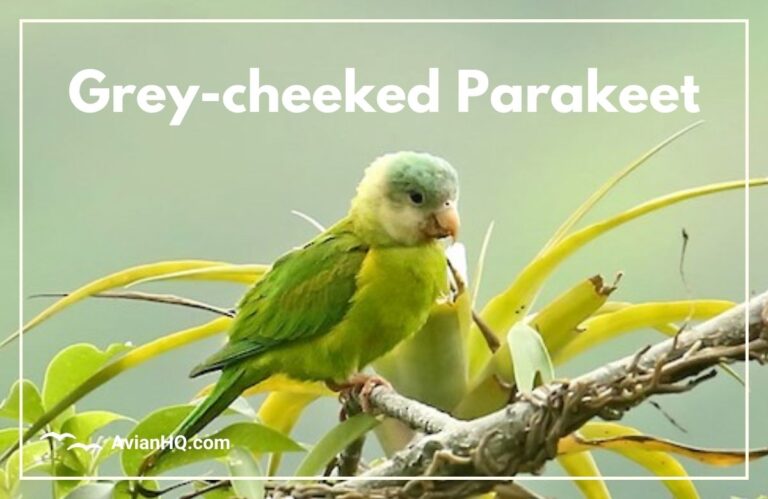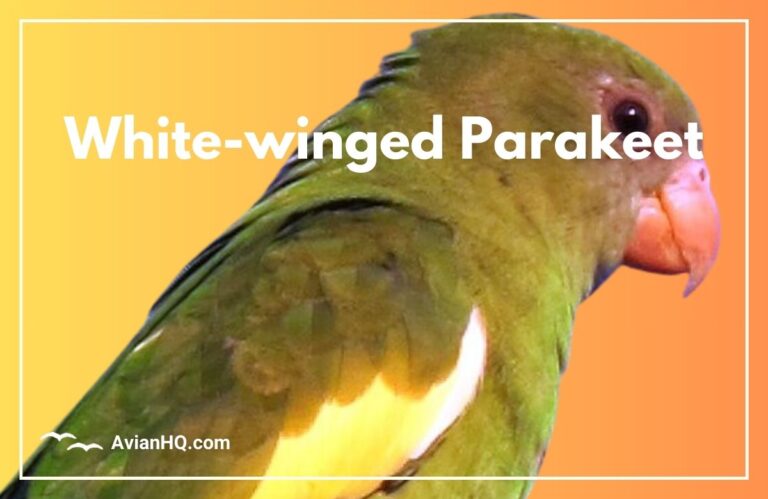Genus: Brotogeris
Have you ever seen a small, colorful parrot with a lot of personality? If so, you may have spotted one of the Brotogeris parakeets. This genus includes 8 playful and smart species of parrots native to South and Central America.
Brotogeris parakeets stand out for their bold body markings and feisty attitudes. They are on the smaller side, averaging 10-12 inches in length with tapered tails and triangular wings. Most species sport green feathers mixed with splashes of colors like yellow, orange, gray, cobalt blue, or white. Their colorful plumage and curious nature makes them fun to observe in the wild.
These parakeets all share a few common traits:
- Playful, social personalities
- Ability to mimic sounds and human speech
- Small but strong curved beaks for cracking seeds and nuts
- Mostly green coloration with bold markings in other colors
- Native to forest, woodland, and savanna habitats in South/Central America
But each Brotogeris species also has unique features and behaviors all their own. Over the next few sections we’ll spotlight what makes each of these parakeets special. Learning how to identify the different species can be challenging – even for experts!
Beyond their physical traits, Brotogeris parakeets display impressive intelligence. They are known to not only mimic human vocalizations, but also understand meanings behind some words and phrases. Some species even use basic tools to get food. We’ll explore more about the smarts these small parrots possess later on.
Sadly though, deforestation and the pet trade threatens many populations of Brotogeris parakeets in the wild. But there are ways we can help protect these special birds. By the end, you’ll know what makes this genus so iconic plus small actions you can take to contribute to their conservation.
Species Spotlights
The genus Brotogeris contains 8 species of small, vibrant parakeets. Let’s meet these charismatic birds!
Yellow-chevroned Parakeet
The Yellow-chevroned Parakeet sports bright yellow “chevrons” along its wings and back. These yellow V-shaped wing bars distinguish it from other similar parakeets.
These birds grow to about 11 inches (28 cm) long. Their green feathers mix with gray around the eyes and nape, yellow wing markings, and pale blue patching around the rump. Their beaks are reddish-orange.
Yellow-chevrons inhabit lowland rainforests and wooded regions of northern and central South America. They live across parts of Colombia, Venezuela, Ecuador, Peru, Bolivia, and Brazil.
These social birds travel in small flocks foraging for fruit, seeds, blossoms. They make a range of whistling and chattering vocalizations.
Golden-winged Parakeet
One look at this parakeet gives away how it got its name. The Golden-winged Parakeet dazzles with vibrant golden-yellow feathers under its wings and tail.
Reaching just over a foot long (30 cm), these parakeets have green plumage on the head, back, and breast. Their yellow wing patches contrast with blue on the trailing wing edges. Females can be identified by their duller orange beaks versus the males’ bright red beaks.
Golden-wings inhabit forests and woodlands of central South America – largely Brazil, Paraguay, Bolivia and bordering areas. They stick to the tree canopy, foraging for fruit and seeds in small, noisy flocks.
Cobalt-winged Parakeet
The brilliant Cobalt-winged Parakeet sports electric blue flight feathers that give it an eye-catching flash of color. These medium-sized parakeets grow around 11 inches (28 cm) long. Beyond the cobalt wings, they have mostly green plumage with gray around the head and yellow-orange beaks.
Cobalt-wings live in forests and savannas of northern South America including Colombia, Venezuela and nearby countries. They prefer habitats near streams or wetlands.
These active birds spend most of their time high in the tall trees. They live in large flocks that chatter excitedly when in flight.
Orange-chinned Parakeet
As the name hints, the Orange-chinned Parakeet is easily identified by its vibrant orange chin and lower face. These colorful mid-sized parakeets reach about 11 inches (28 cm) long. Otherwise its feathers are mainly green, with gray around its head and bluish flight feathers.
The species lives across parts of the Amazon basin in South America, largely northern Brazil and bordering countries. Orange-chins tend to stick to tall rainforest trees, traveling in noisy flocks through the canopy. They use their curved beaks to munch on fruit, seeds and nuts.
Grey-cheeked Parakeet
The Grey-cheeked Parakeet gets its name from the prominent gray patches on its cheeks and crown. These parakeets reach approximately 10 inches (25 cm) long. Their mostly green plumage also contains unique dark red patches underneath the tail.
This species prefers open woodlands and savanna landscapes. Its native range centers around northeastern Brazil but also includes areas of eastern Bolivia and Paraguay.
Grey-cheeks gather in flocks up to 30 birds or more. Their screechy squawks reveal their location as they fly between trees. These vocal parakeets are quite nimble and fast in flight.
Tui Parakeet
The vibrant Tui Parakeet definitely lives up to its billing with rich green and yellow feathers. At just 8 inches (20 cm) long, it is among the smaller Brotogeris parakeets. Beyond the bright emerald body and wings, Tuis have bright yellow heads from the crown down through the nape and cheeks. Their gray beaks perfectly match the gray feet.
Tuis stick to the canopy level in lowland forests of eastern and central Bolivia. They prefer river or gallery forests. Tuis travel in small flocks, communicating in sharp chirps and whistles.
Plain Parakeet
As the name hints, the Plain Parakeet lacks flashy markings seen in other Brotogeris species. With mostly bright green plumage from head to tail, they reach about 10 inches (25 cm) in length. Close inspection reveals some faint scallops along their backs and bluish undersides of tail feathers. Females show lighter yellow-green beaks versus the reddish-orange on males.
These unadorned parakeets live in forest and woodland interiors across eastern Brazil’s interior. They forage for seeds and fruit hidden in the dense vegetation, traveling in small groups of 10 to 20 birds. Their squeaky calls echo through the tree canopy as they fly.
White-winged Parakeet
The White-winged Parakeet, also called Canary-winged Parakeet, shows off vibrant yellow wings in flight. These striking parakeets grow to about 12 inches (30 cm). They have primarily green plumage on the head, back and breast with yellow-white wing patches. Their long tails taper to a point.
White-wings inhabit lowland rainforests across areas of the Amazon basin in South America. Their range spans parts of Colombia, Venezuela, Guyana, Suriname and Brazil. They stick to canopy levels in tall mature forests.
These nimble flyers travel in small flocks through the treetops, using their curved beaks to pluck fruit and nuts. Flocks chatter excitedly with screeches and whistles as they swoop overhead. The yellow wing flashes make White-wings a delight to spot.
Behavior and Intelligence
Beyond physical traits, Brotogeris parakeets also share common behaviors and intellectual abilities that set them apart.
Social Behavior
All species of Brotogeris parakeets live in social groups ranging from small family flocks to large communal roosts. They groom one another, travel together, and roost side-by-side at night.
Many groups participate in lively flight displays around dusk. Hundreds of parakeets may congregate, calling excitedly and maneuvering rapidly through the air in synchronized patterns before settling into treetop roosts.
Their strong social bonds are also evident in captive birds. Brotogeris parakeets housed together will interact extensively with cagemates.
Communication Methods
Wild Brotogeris communicate vocally with a diverse repertoire of squawks, chirps, whistles and chatter. Their excited vocal exchanges create a near-constant soundtrack to a flock in flight.
In captivity, they eagerly mimic household sounds like telephones ringing, microwave beeps, and even human speech. Some species like the Grey-cheeked Parakeet have larger natural vocal range and often prove skilled talkers.
Puzzle Solving and Tool Use
Research shows that parrots in the genus Brotogeris display notable intelligence solving problems to access food or other needs.
Several species have demonstrated sequential tool use in lab tests – retrieving one object to reach another. Grey-cheeked parakeets show particular skill using tools compared to other Brotogeris species as well as many other birds.
Tests also reveal insight into quantitative concepts. Captive birds can distinguish between quantities and choose the larger or smaller option appropriately. This suggests advanced abstract reasoning.
While less studied than larger parrot genera, Brotogeris species likely possess intelligence on par with other smart avian groups like macaws or cockatoos. Their aptitude for learning, tool use and problem solving hints at a high level of avian cognition.
Cultural Significance
The small size, vibrant colors, mimicry ability and intelligence of Brotogeris parakeets has made them appealing as pets and performers across cultures for centuries.
History of Domestication
There is evidence that Native Amazonian and Andean cultures kept small parrots as pets or ceremonial birds long before European contact. The Cherokee and other North American tribes reportedly practiced parrot keeping after trade networks brought tropical birds northward.
Once European settlers established trade routes from South America in the 1800s, various Brotogeris species were among the most exported wildlife. Demand flourished both for living birds as cage pets as well as taxidermy specimens from collectors and museums.
Today they remain commonly bred and sold in the worldwide pet industry. The Canary-winged Parakeet is especially heavily traded for its bright coloration.
Roles as Pets and Performers
Around the world, the most popular roles of Brotogeris parakeets are as household pets and performer birds.
As pets, these parakeets are beloved for their playful antics, small size care needs, and bonds with owners. Their affectionate nature and comical squirrel-like feeding behaviors make them delightful to observe.
Some parakeets have found fame as animal actors in television shows, movies and commercials. Trainers take advantage of their beauty, intelligence and willingness to mimic. The Canary-winged Parakeet often appears onscreen due to its striking yellow wing patches.
Zoos have also exhibited Brotogeris species in aviaries to educate and delight visitors. Children find their active, mischievous ways quite amusing!
Significance in Native Cultures
Brotogeris parakeets have held significance in indigenous cultures of South and Central America for ages. Ancient peoples incorporated parakeet colors and designs into traditional textiles, ceramics and handicrafts. Certain species appeared in origin stories or religious rituals.
Even today, images of parakeets like the Canary-winged Parakeet remain an iconic symbol decorating art from Central American to Amazonian tribes. Though cultural practices evolve, this genus still holds an important place in many regional cultures.
Threats and Conservation
Despite their popularity in captivity, Brotogeris parakeet populations face concerning declines in the wild. Habitat loss and trapping for illegal wildlife trade imperil several species.
Habitat Loss
The primary threat across the genus is destruction of native forest and woodland habitats. Land clearance for agriculture, logging, and development destroys the old-growth trees these parakeets rely on for nesting and food sources.
For example, only 10% of suitable habitat remains for the endangered Golden-winged Parakeet. Deforestation could destabilize populations past the point of recovery if protective measures aren’t taken.
Capture for Pet Trade
Parrot breeding cannot satisfy market demand for unique species like Brotogeris parakeets. As a result, trappers illegally take tens of thousands of wild parrots annually to sell as pets. This worsens the problem of habitat loss.
The colorful Canary-winged Parakeet is most coveted for the pet industry and critically endangered. However even less striking species like the Plain Parakeet get poached from Brazil’s interior forests.
Aggressive trapping for three decades leaves the Canary-winged Parakeet “one step from extinction” according to scientists. Just 3 isolated groups likely survive in Venezuela. Without intervention, this iconic bird will vanish.
Conservation Status
The two rarest species – the Canary-winged and Golden-winged Parakeets – rank among the most threatened parrots globally. Both are endangered according to the IUCN Red List:
- Canary-winged Parakeet: Critically Endangered
- Golden-winged Parakeet: Endangered
Several others face concerning population declines:
- Cobalt-winged Parakeet: Vulnerable
- Tui Parakeet: Near Threatened
- Plain Parakeet: Near Threatened
Urgent actions to curb trafficking and protect habitats are needed to prevent extinctions.
Conservation Efforts
While the situation is troubling, active rescue and breeding programs like Brazil’s Centro de Pesquisa para Conservação das Aves Silvestres offer hope. These facilities shelter seized wild parakeets and breed them until populations stabilize enough for re-release.
The World Parrot Trust and other organizations lead initiatives to expand protected forest reserves and crack down on smugglers. More revelations from the pet trade about parrot intellect also sparks greater pressure to end poaching practices and safeguard their remaining forests for good.
Everyday people also make an impact through activism, responsible pet ownership, donations and volunteering. Check out [insert site] to discover easy ways you can contribute to save these remarkable birds!
Conclusion
The diverse parakeets of the genus Brotogeris showcase the captivating qualities that make parrots global favorites – beauty, brains and personality. Sadly though, many of these species now face extinction in the wild without urgent conservation efforts.
The brilliant Canary-winged Parakeet and its dazzling yellow wings stands on the brink as deforestation and trafficking rob them of remaining habitat. The scarce Golden-winged Parakeet also nears a precarious point as its last sanctuary forests vanish. Time is running out to ensure future generations can enjoy these birds outside of captivity.
Yet committed conservationists and activists lead the charge to intervene on behalf of Brotogeris parakeets. Through habitat restoration, enforcement efforts, responsible pet ownership and public pressure, we can still protect these special parakeets.
Join the cause today by reaching out to support groups fighting for the survival of the Canary-winged Parakeet, Golden-winged Parakeet and others worldwide. You also can make responsible choices when it comes to owning parrots as pets. Follow permit laws, never remove birds from the wild, and research sources to ensure lawfully captive-bred animals.
With louder demands for action from voting citizens, governments and landholders may dedicate more safe forest preserves for endangered Brotogeris species. Though small, everyday people make big waves when we come together to champion needed change.
The sweet, mischievous nature of Brotogeris allows them to charm almost anyone who encounters them in forests or homes. Ensure future folks can still experience the joy of these feisty, bright parakeets by adding your voice to their conservation fight today!

